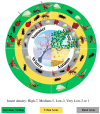Floral Resource Integration: Enhancing Biocontrol of Tuta absoluta Within Sustainable IPM Frameworks
- PMID: 39942881
- PMCID: PMC11821143
- DOI: 10.3390/plants14030319
Floral Resource Integration: Enhancing Biocontrol of Tuta absoluta Within Sustainable IPM Frameworks
Abstract
The tomato leaf miner, Tuta absoluta, is a pest threatening global tomato production. This pest's adaptability and resistance to chemical insecticides have necessitated integrated pest management (IPM) strategies prioritizing sustainable alternatives. This review explores the role of biological control agents (BCAs) in managing T. absoluta populations, emphasizing the integration of floral resources to enhance their efficacy. Predatory mirids such as Macrolophus pygmaeus and Nesidiocoris tenuis and parasitoids such as N. artynes and Trichogramma spp. are pivotal in pest suppression; however, their performance depends on nutritional and habitat support. Floral resources provide essential sugars and proteins, improving the longevity, fecundity, and predation efficiency of these BCAs. This review synthesizes case studies highlighting the benefits of selected flowering plants, such as Lobularia maritima and Fagopyrum esculentum, in supporting predator and parasitoid populations while minimizing advantages to T. absoluta. Mechanisms such as nectar quality, floral accessibility, and spatial-temporal resource availability are explored in detail. Additionally, the challenges of selective floral attraction, microbial impacts on nectar composition, and the unintended support of non-target organisms are discussed. This review proposes targeted floral management strategies to optimize BCA performance within IPM systems by integrating ecological and chemical insights. This approach offers a pathway toward reducing chemical pesticide reliance, fostering sustainable agriculture, and mitigating the economic impacts of T. absoluta infestations.
Keywords: T. absoluta; biological control agents; floral resource management; integrated pest management; sustainable agriculture.
Conflict of interest statement
The authors declare no conflicts of interest.
Figures



References
-
- Desneux N., Wajnberg E., Wyckhuys K.A., Burgio G., Arpaia S., Narváez-Vasquez C.A., González-Cabrera J., Catalán Ruescas D., Tabone E., Frandon J. Biological invasion of European tomato crops by Tuta absoluta: Ecology, geographic expansion and prospects for biological control. J. Pest Sci. 2010;83:197–215.
-
- Balzan M.V., Moonen A.C. Management strategies for the control of Tuta absoluta (L epidoptera: G elechiidae) damage in open-field cultivations of processing tomato in Tuscany (Italy) EPPO Bull. 2012;42:217–225. doi: 10.1111/epp.2558. - DOI
-
- Guedes R., Picanço M. The tomato borer Tuta absoluta in South America: Pest status, management and insecticide resistance. EPPO Bull. 2012;42:211–216. doi: 10.1111/epp.2557. - DOI
Publication types
Grants and funding
LinkOut - more resources
Full Text Sources
Miscellaneous

